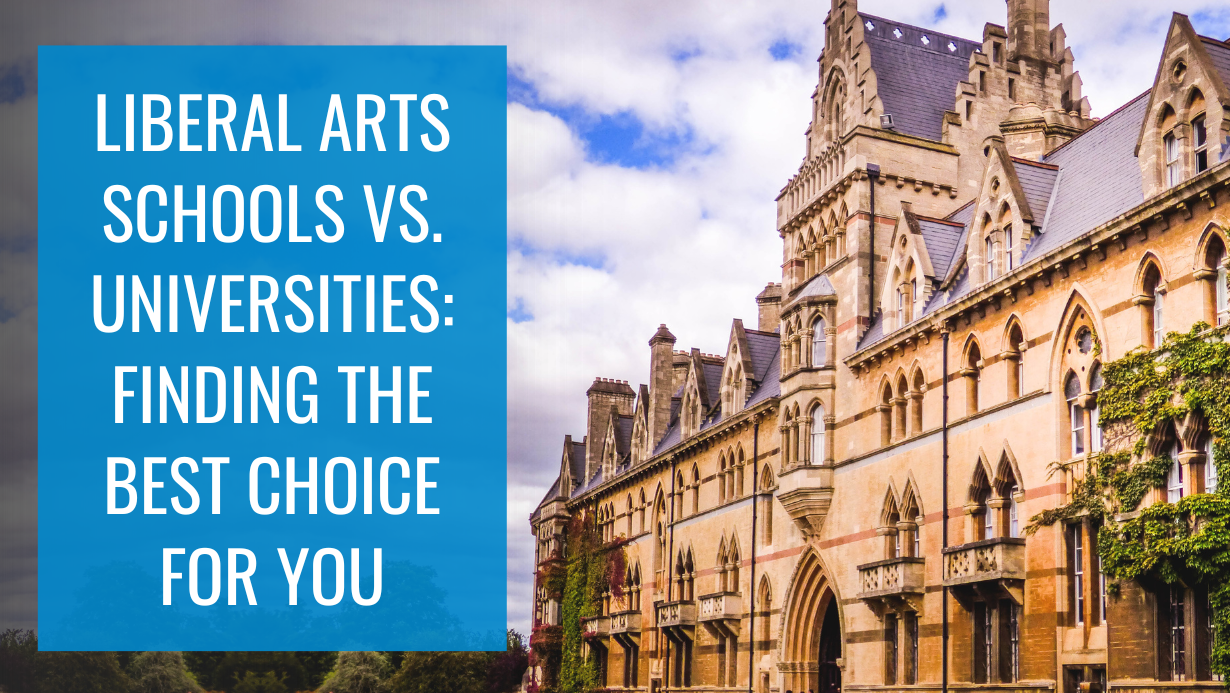Are you a prospective student unsure of whether to attend a liberal arts college or a university? Choosing the right educational institution is a crucial decision that will shape your academic and professional journey. You may be asking yourself, are liberal arts schools better than universities? Or even, what is the difference between liberal arts colleges and universities?
While both liberal arts schools and universities offer higher education, they differ in several key ways. In this blog post, we will explore the differences between liberal arts schools and universities to help you make an informed decision.

Curriculum and Focus
One of the primary differences between liberal arts schools and universities is their curriculum and focus. Liberal arts schools offer a well-rounded education that covers a broad range of subjects, including humanities, sciences, social sciences, and arts. The curriculum is designed to expose students to a diverse set of subjects and develop critical thinking, analytical, and communication skills. Students at liberal arts schools often have the flexibility to explore various disciplines before declaring a major.
On the other hand, universities typically have a larger and more specialized curriculum with a focus on specific fields of study. Universities often offer a wider range of majors and programs, allowing students to specialize in a particular area of interest. Universities may also have more research opportunities and advanced courses in specific fields.
Class Size and Interaction
Class size and interaction with faculty are important factors to consider when choosing between a liberal arts school and a university. Liberal arts schools are known for their smaller class sizes, which foster close relationships between students and faculty. Professors at liberal arts schools often provide individual attention to students, and class discussions are encouraged, creating an engaging and collaborative learning environment. Students have more opportunities to participate in class, ask questions, and interact with professors, which can enhance their overall learning experience.
Universities, on the other hand, tend to have larger class sizes, especially in lower-level courses. This can make it more challenging for students to develop close relationships with professors and actively participate in class discussions. However, universities often have more resources, such as research facilities, libraries, and guest lecturers, which can provide additional learning opportunities outside of the classroom.
Extracurricular Activities and Campus Life
Another difference between liberal arts schools and universities is the extracurricular activities and campus life. Liberal arts schools typically have smaller campuses and smaller student populations, which can create a close-knit community. Students may have more opportunities to participate in extracurricular activities, such as clubs, sports, and arts, and take on leadership roles. Campus life at a liberal arts school can be more intimate and provide a sense of belonging and community.
Universities, on the other hand, often have larger campuses and a very diverse student population. This can provide a wider array of extracurricular activities and a more vibrant campus life. Universities may have more sports teams, clubs, and cultural organizations, offering a greater variety of options for students to get involved. However, the larger size of universities may also make it more challenging for students to establish close-knit communities.
Research Opportunities
While both liberal arts schools and universities may offer research opportunities, the scope and scale of research can differ. Universities, especially those with strong graduate research programs, often have larger budgets and more resources for research. They may have state-of-the-art laboratories, research centers, and funding for research projects. As a result, universities can provide more extensive opportunities for students to engage in cutting-edge research and work closely with faculty on research projects.
Liberal arts schools, on the other hand, may have smaller research programs due to limited resources. However, this does not mean that they lack research opportunities altogether. Liberal arts schools may offer research opportunities in smaller groups or one-on-one settings with faculty, providing a more intimate and hands-on research experience. Research opportunities at liberal arts schools may also be more interdisciplinary, allowing students to explore a broader range of topics and collaborate with faculty from different disciplines.
Tuition and Costs
Tuition and costs are important considerations for prospective students. Liberal arts schools tend to have higher tuition rates compared to public universities, although there are variations depending on the specific institution.
Prestige
Prestige is another factor that may differ between liberal arts schools and universities. Universities, especially those that are large and have a long-established history, are often renowned for their reputation, rankings, and brand recognition. They may have a higher level of prestige and be well-known for their distinguished faculty, research output, and alumni success. Universities may also have stronger connections with industry leaders and renowned experts in various fields, which can open doors for networking and career opportunities.
On the other hand, while liberal arts schools may not have the same level of prestige as universities, they are often known for their unique approach to education and emphasis on small class sizes, close faculty-student relationships, and interdisciplinary learning. Liberal arts schools may have a more personalized and nurturing environment that fosters individual growth and development. Graduates from liberal arts schools may also be highly regarded for their well-rounded education and transferable skills, which can make them stand out in the job market.
Career Opportunities
Both liberal arts schools and universities can provide excellent career opportunities, but they may differ in how they prepare students for the job market. Liberal arts schools focus on developing well-rounded individuals with critical thinking, problem-solving, and communication skills that are highly valued in today’s job market. Graduates from liberal arts schools are often sought after by employers for their ability to adapt to different situations, think critically, and communicate effectively.
Universities, on the other hand, may provide more specialized training and professional programs that are tailored to specific fields. Universities often have strong connections with industry partners and may offer internships, co-op programs, and research opportunities that can provide practical experience and help students build a professional network.
Liberal Arts vs. Universities
In conclusion, the decision between a liberal arts school and a university depends on your individual preferences and goals. Liberal arts schools offer a well-rounded education with smaller class sizes, a focus on critical thinking and communication skills, and a close-knit community. Universities, on the other hand, may offer a more specialized curriculum, larger research opportunities, and a potentially higher level of prestige.
Consider your academic interests, learning style, career aspirations, and financial considerations when making your decision. Ultimately, the right choice for you will depend on your individual needs and priorities as a prospective student. Our Solomon consultants are great resources to help you make this decision based on your needs and future career goals. If you are interested in learning more about the support a college admissions consultant can provide, please contact us today!

Former Senior Admissions Counselor at University of Chicago
2 years in University of Chicago Admissions
4,000+ Applications Read and Evaluated
After graduating from the University of Chicago with a major in Geographical Studies and a minor in Art History, Maura joined the Office of Undergraduate Admissions at UChicago. In her two years there, she recruited students from across the country, evaluated more than 4,000 UChicago applications, offered information sessions on applying to highly selective universities, led educational essay writing workshops, and advocated for students in the admissions committee.



